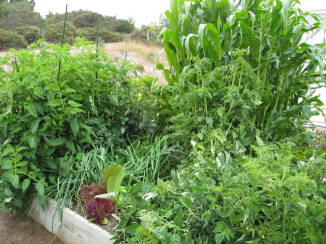 There had been a two foot wide path between the raised beds. And four feet between the beds and the fence. However in the last week the paths have begun to disappear under the vegetation. Everything seems to be a lot taller than I was expecting it to grow — and I don’t mean the extra almost a foot that the raised beds provides. I don’t know what I was thinking. I guess I wasn’t very optimistic about how well the garden would grow.
There had been a two foot wide path between the raised beds. And four feet between the beds and the fence. However in the last week the paths have begun to disappear under the vegetation. Everything seems to be a lot taller than I was expecting it to grow — and I don’t mean the extra almost a foot that the raised beds provides. I don’t know what I was thinking. I guess I wasn’t very optimistic about how well the garden would grow.
For a while, that seemed like the correct view. However, in the last couple weeks a critical mass situation must have arisen with the vegetation being sufficient so that the plants started blooming and putting out a lot more growth as well. The pumpkins are taking over one corner of the garden area. And the tomatoes have claimed the opposite corner. The stakes I used for the tomatoes were overwhelmed by the plants and disappeared in the foliage. A few days ago I noticed that the tomatoes were starting to lean over to one side — they were bending the stakes or pulling them out of the ground. I added more stakes by one set of problem plants and ran string around the whole thing to hold it in place. No sooner than that was done then I realized another group was tilting. By time I went out the next morning, two tomato plants were laying on the savory and basil while a third when across the path to rest on the cornstalks.
 The seed catalogs list these varieties as “indeterminate” — thus no maximum height given. The slightly less than a foot depth of the raised beds was not enough to anchor the stakes for the now heavy plants. Even if there wasn’t the hardware cloth gopher barrier below, I suspect I still would have had problems with the staking. Now that I saw what happened, I have a sense of deja-vu. My first garden in Saratoga used stakes instead of cages for the tomatoes. I switched to wire cages and things were so much better in later years.
The seed catalogs list these varieties as “indeterminate” — thus no maximum height given. The slightly less than a foot depth of the raised beds was not enough to anchor the stakes for the now heavy plants. Even if there wasn’t the hardware cloth gopher barrier below, I suspect I still would have had problems with the staking. Now that I saw what happened, I have a sense of deja-vu. My first garden in Saratoga used stakes instead of cages for the tomatoes. I switched to wire cages and things were so much better in later years.
It is too late for wire cages this year. For now, 6 foot T-posts just outside the beds next to the groups of tomatoes will have to do. Between them there are four or five rows of jute string with the tomatoes captured in the middle. There were some crunching noises coming from the plants as I tried to get them upright. Time will tell if it the plants are completely broken or just badly battered. Next year I will have wire cages for the tomatoes and also as a trellis for the peas.
The honeybees are now including the garden in their daily routine. We went from none to a couple dozen workers buzzing around the flowers. No longer do I need to worry about zucchini blossoms getting pollinated. I am back to the usual problem with zucchini — what to do with so many of them. The other squash and pumpkins have also started showing fruit as a result of the bees’ efforts. We should have several nice pumpkins for Halloween decorations and Thanksgiving pies.
If I ever had any doubt about the bees acting as pollination agents, it would have been removed by a bee I saw a couple weeks ago near the just opening sunflowers. I had heard a buzzing and when I first caught a glimpse, I saw yellow and thought it might be a pesky yellow jacket. But then it landed on a sunflower and I discovered what the yellow color was — lots of pollen on the back of the honeybee.

 There had been a two foot wide path between the raised beds. And four feet between the beds and the fence. However in the last week the paths have begun to disappear under the vegetation. Everything seems to be a lot taller than I was expecting it to grow — and I don’t mean the extra almost a foot that the raised beds provides. I don’t know what I was thinking. I guess I wasn’t very optimistic about how well the garden would grow.
There had been a two foot wide path between the raised beds. And four feet between the beds and the fence. However in the last week the paths have begun to disappear under the vegetation. Everything seems to be a lot taller than I was expecting it to grow — and I don’t mean the extra almost a foot that the raised beds provides. I don’t know what I was thinking. I guess I wasn’t very optimistic about how well the garden would grow.